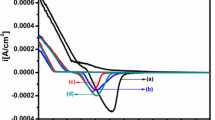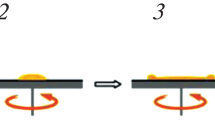Abstract
Electrochemical deposition (ECD) of ZnSe thin films from aqueous solution containing ZnSO4·7H2O, SeO2 and different complexing agents at bath maintained at 50 °C were investigated. The voltammetric curves were recorded in order to characterize the electrochemical behavior of Zn2+/SeO2 system with different complexing agent and to apply the appropriate range of potential for ECD. GAXRD studies confirms that as-deposited ZnSe thin films using with different complexing agents belongs to the hexagonal phase with (101) plane as the dominant peak. When EDTA, hydrazine hydrate and triethanolamine as complexing agents used, as-deposited films were shows that peaks due to the hexagonal phase along with hexagonal Se reflection observed. EDAX, AES, FESEM and UV–Visible spectrum were used to examine the compositions, morphologies and band gap of ZnSe thin films deposited on ITO glass substrate. A broad photoluminescence (PL) emission peak has been confirmed by a systematic blue-shift in emission peak due to the formation of nanocrystalline ZnSe thin films. In the Raman spectra, high intensity peak of LO phonon mode is observed at 251 cm−1 using ammonia, citric acid, ethylenediamine and polyvinyl alcohol as a complexing agents. For EDTA, hydrazine hydrate and triethanolamine as a complexing agents used, the phonon was shifted toward lower frequencies. The conductivity type, resistivity, carrier concentrations and electron mobility were measured for the as-deposited ZnSe thin films. As-deposited ZnSe thin films using all complexing agents have n-type conductivity. Electrochemical impedance spectroscopy (EIS) indicated that the ethylenediamine as a good complexing agent for ZnSe thin film deposition and the films demonstrate a less charge transfer resistance (Rct is 11 Ω) with excellent conductivity compared to other samples.












Similar content being viewed by others
References
R. Henríquez, H. Gómez, G. Riveros, J.F Guillemoles, M. Froment, D. Lincot, Electrochemical deposition of ZnSe from dimethyl sulfoxide solution and characterization of epitaxial growth. J. Phys. Chem. B. 108(35), 13191–13199 (2004). doi:10.1021/jp0486191
A. Wei, X. Zhao, J. Liu, Y. Zhao, Investigation on the structure and optical properties of chemically deposited ZnSe nanocrystalline thin films. Physica B 410, 120–125 (2013). doi:10.1016/j.physb.2012.10.031
R. Kowalik, K. Fitzner, Analysis of the mechanism for electrodeposition of the ZnSe phase on Cu substrate. J. Electro. Chem. 633, 78–84 (2009). doi:10.1016/j.jelechem.2009.04.029
S.R. Kumar, M. Nuthalapati, J. Maity, Development of nanocrystalline ZnSe thin film through electrodeposition from a non-aqueous solution. Scripta Mater. 67, 396–399 (2012). doi:10.1016/j.scriptamat.2012.05.029
R. Sahraei, A. Daneshfar, A. Goudarzi, S. Abbasi, M.H. Majles Ara, F. Rahimi, Optical properties of nanocrystalline ZnS:Mn thin films prepared by chemical bath deposition method. J. Mater. Sci. Mater. Electron. 24, 260–266 (2013) doi:10.1007/s10854-012-0730-9
H. Metin, S. Durmuş, S. Erat, M. Ari, Characterization of chemically deposited ZnSe/SnO2/glass films: influence of annealing in Ar atmosphere on physical properties. Appl. Surf. Sci. 257, 6474–6480 (2011). doi:10.1016/j.apsusc.2011.02.047
R. Kowalik, P. Zabinski, K. Fitzner, Electrodeposition of ZnSe. Electrochim. Acta, 53, 6184–6190 (2008). doi:10.1016/j.electacta.2007.12.009
G. Riveros, H. Gómez, R. Henríquez, R. Schrebler, R.E. Marotti, E.A. Dalchiele, Electrodeposition and characterization of ZnSe semiconductor thin films. Sol. Energy Mater. Solar Cells 70, 255–268 (2001). doi:10.1016/S0927-0248(01)00066-6
L. Chen, J.S. Lai, X.N. Fu, J. Sun, Z.F. Ying, J.D. Wu, H. Lu, N. Xu, Growth of ZnSe nano-needles by pulsed laser deposition and their application in polymer/inorganic hybrid solar cells. Thin Solid Films, 529, 76–79 (2013). doi:10.1016/j.tsf.2012.02.037
J. Liu, A.X. Wei, M.X. Zhuang, Y. Zhao, Investigation of the ZnSxSe1–x thin films prepared by chemical bath deposition. J. Mater. Sci. Mater Electron, 24, 1348–1353 (2013). doi:10.1007/s10854-012-0932-1
M. Gaurav, D. Lohar, Haridas, A. Dhaygude, Ranjit, Ma Patil, Yuan-Ron, J.V. Fulari, Studies of properties of Fe2+ doped ZnSe nano-needles for photoelectrochemical cell application. J. Mater. Sci. Mater. Electron 26, 8904–8914 (2015). doi:10.1007/s10854-015-3572-4
P. Prabukanthan, G. Harichandran, Electrochemical deposition of n-type ZnSe thin film buffer layer for solar cells. J. Electrochem. Soc. 161, D736–D741 (2014). doi:10.1149/2.0261414jes
B.E. Warren, X-ray Diffraction, Dover, New York, (1990)
K. Yadav, Y. Dwivedi, N. Jaggi, Structural and optical properties of Ni doped ZnSe nanoparticles. J. Lumin 158, 181–187 (2015). doi:10.1016/j.jlum2014.09.025
T.M. Khan, M. Zakria, M. Ahmad, I.R. Shakoor, Optoelectronic study and annealing stability of room temperature pulsed laser ablated ZnSe polycrystalline thin films. J. Lumin 147, 96–103 (2014). doi:10.1016/j.jlum2013.10.064
Acknowledgements
P.P would like to acknowledge the financial support of Science & Engineering Research Board (SERB), Department of Science and Technology (DST), Fast Track Research Scheme, India.
Author information
Authors and Affiliations
Corresponding author
Rights and permissions
About this article
Cite this article
Prabukanthan, P., Rajesh Kumar, T. & Harichandran, G. Influence of various complexing agents on structural, morphological, optical and electrical properties of electrochemically deposited ZnSe thin films. J Mater Sci: Mater Electron 28, 14728–14737 (2017). https://doi.org/10.1007/s10854-017-7341-4
Received:
Accepted:
Published:
Issue Date:
DOI: https://doi.org/10.1007/s10854-017-7341-4




